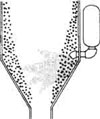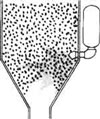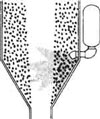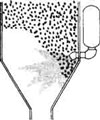Everything You Ever Wanted to Know About Air Cannons... but were afraid to ask
So you have material flow problems like sticking, clogging, ratholing and bridging. How do you know whether to use an air cannon or a vibrator?
MATERIAL TYPE
Air cannons are most effective on low density material. Fine powders and fluffy, lightweight material like wood chips and saw dust easily absorb vibration - making air cannons a better choice. ."Stringy", irregular and faceted particles have a tendency to lock together. The blast of an air cannon separates locked particles and promotes flow.
BIN CONSTRUCTION
Heavily reinforced or rigid bins - including those made of concrete and heavy gauge steel - may not respond well to vibration and are prone to material flow problems. Coal and ore bins, grain silos and elevators, and large mineral hoppers are all ideal areas to use air cannons because they are not affected by the rigidity of the bin construction.
How Do Air Cannons Solve Material Flow Problems?
An Air Cannon consists of a high pressure tank that stores compressed air (80-125 PSI), and a quick release piston valve. When the air cannon is activated (via a solenoid valve), it delivers a high-powered blast of air into the bin or silo. The blast breaks the friction between the particles and the bin walls, releasing and fluidizing the material.
Play the short animation to the right to see the action of an air cannon.
Types of Material Flow Problems Solved With Air Cannons
 |  |  |  |
| Sticking to Sides | Bridging | Ratholing | Arching |
Learn more about air cannons at http://www.vibco.com/products/air-cannons or request assistance selecting the right air cannon for your needs now http://www.vibco.com/service-manuals/request-technical-support